
WHAT IT TAKES
Time: 1 weekend
Skill level: Beginner

WHAT IT TAKES
Time: 1 weekend
Skill level: Beginner
Here’s a wood floor that’s so easy to install you can complete an average-size room in a weekend. The joints just snap together. Simple carpentry skills and a few basic tools are all you need to cut the floorboards and notch them around corners.
In this article, we’ll show you how to prepare your room and lay the snap-together flooring. The flooring we’re using is similar to snap-together laminate floors except that it has a surface layer of real wood. The 5/16-in.-thick flooring has specially shaped tongues and grooves that interlock to form a strong tight joint without glue or nails. Once assembled, the entire floor “floats” in one large sheet. You leave a small expansion space all around the edges so the floor can expand and contract with humidity changes.

Wood veneer floors cost $5 to $15 per sq. ft., depending on the species, thickness of the top wood layer and underlayment and trim. Most home centers sell a few types of snap-together floors, but you’ll find a better selection and expert advice at your local flooring retailer. You can also buy flooring online.
Before you go shopping, draw a sketch of your room with dimensions. Make note of transitions to other types of flooring and other features like stair landings and exterior doors. Ask your salesperson for help choosing the right transition moldings for these areas.
You’ll need a few special tools in addition to basic hand tools like a tape measure, square and utility knife. We purchased an installation kit from the manufacturer that included plastic shims, a tapping block and a last-board puller, but if you’re handy you could fabricate these tools. You’ll also need a circular saw and a jigsaw to cut the flooring, and a miter box to cut the shoe molding. A table saw and power miter saw would make your job easier but aren’t necessary.
Don’t lay this type of floor over damp concrete or damp crawlspaces. Check all concrete for excess moisture. As a starting point, use the plastic mat test shown in Photo 1. Even though some manufacturers allow it, professional installers we spoke to advised against installing floating floors in kitchens, full or three-quarter baths, or entryways, all areas where they might be subjected to standing water.
You have to make sure the existing floor is smooth and flat before installing a floating floor on top. Clear the old floor, then smooth it by scraping off lumps and sweeping it. Check the floor with an 8-ft. straightedge and mark high spots and depressions. Sand or grind down ridges and fill low spots (Photo 2). Most manufacturers recommend no more than 1/8-in. variation in flatness over an 8-ft. length.
Allowing the floor to expand and contract freely is critical. Leave at least a 3/8-in. expansion space along the edges. You can hide the gap under the baseboards or leave the baseboards in place and cover the gap with shoe molding or quarter round as we did. Cover the expansion space at openings or transitions to other types of flooring with special transition moldings (Photo 13). Buy these from the dealer.
Finally, saw off the bottoms of door jambs and trim to allow for the flooring to slide underneath (Photo 3). Leaving an expansion gap at exterior doors presents a unique challenge. In older houses, you could carefully remove the threshold and notch it to allow the flooring to slide underneath. For most newer exterior doors, you can butt a square-nosed transition piece against the threshold.
Floating floors must be installed over a thin cushioning pad called underlayment (Photo 5). Underlayment is usually sold in rolls and costs 25¢ to 50¢ per sq. ft. Ask your flooring dealer to suggest the best one for your situation. Some types combine a vapor barrier and padding. Install this type over concrete or other floors where moisture might be a problem. Others reduce sound transmission.
Take extra care when installing underlayment that includes a vapor barrier. Lap the edges up the wall and carefully seal all the seams as recommended by the manufacturer. Keep a roll of tape handy to patch accidental rips and tears as you install the floor.
You may have to cut your first row of flooring narrower to make sure the last row is at least 2 in. wide. To figure this, measure across the room and divide by the width of the exposed face on the flooring. The number remaining is the width of the last row. If the remainder is less than 2, cut the first row narrower to make this last row wider. Then continue the installation as shown in Photos 6 – 8.
You can’t use the same tilt-and-snap installation technique where the flooring fits under door jambs. You have to slide the flooring together instead. Photos 9 – 12 show how. If the opening requires a transition molding, cut the flooring short to leave space for it (Photo 13).
Complete the floor by cutting the last row to the correct width to fit against the wall. Make sure to leave the required expansion space. Finally, reinstall the baseboards if you removed them, or install new quarter-round or shoe molding to cover the expansion space (Photo 14).
To find snap-together wood veneer floors, check with your local home center or flooring supplier, or go online and search “wood veneer floors” and “floating wood floors.”
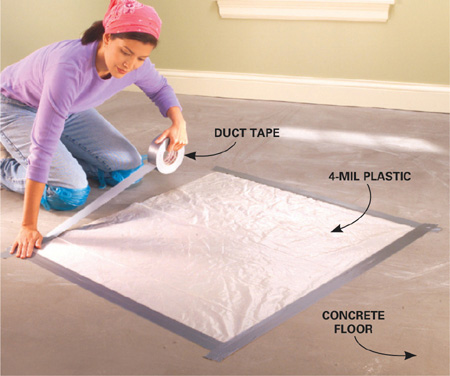
1 Test for excess moisture in concrete floors by sealing the edges of a 3-ft. square of plastic sheeting to the floor with duct tape. Wait 24 hours before you peel back the plastic to check for moisture. Water droplets on the plastic or darkened concrete indicate a possible problem with excess moisture. Ask your flooring supplier for advice before installing a wood floor.
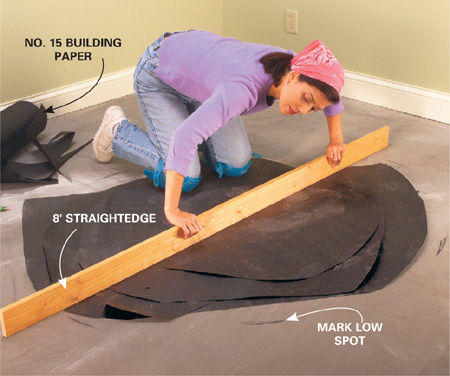
2 Check for low spots in the floor with an 8-ft. straightedge and mark their perimeter with a pencil. Fill depressions less than 1/4 in. deep with layers of building paper. Fill deeper depressions with a hardening-type floor filler available from flooring stores.
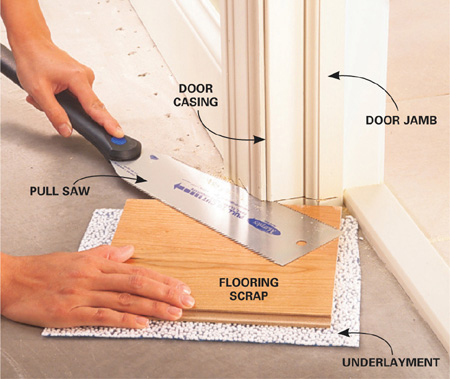
3 Undercut door jambs and casings (door moldings) to make space for the flooring to slip underneath. Guide the saw with a scrap of flooring stacked on a piece of underlayment.
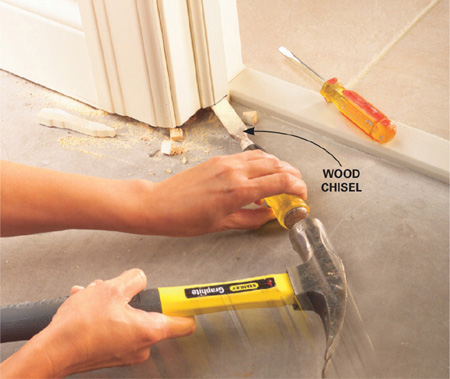
4 Break and pry out the cutoff chunks of jamb and casing with a screwdriver. Use a sharp chisel or utility knife to complete the cut in areas the saw couldn’t reach.
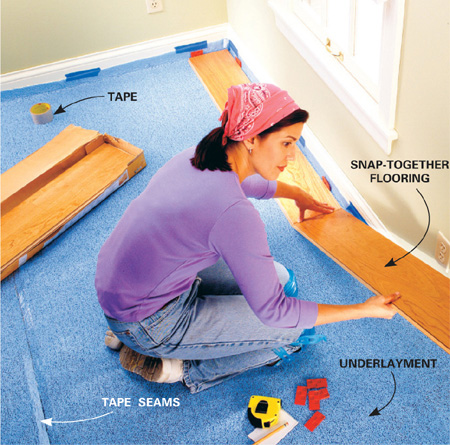
5 Unroll the underlayment and lap it up the baseboards or walls 2 in. Temporarily secure the edges with masking tape. Butt the sheets together and seal the seams with the tape recommended by the manufacturer. Cut the first row of boards narrower if necessary to ensure that the last row of flooring will be at least 2 in. wide. Then start the installation by locking the ends of the first row of flooring together. Measure and cut the last piece to fit, allowing the 3/8-in. expansion space.
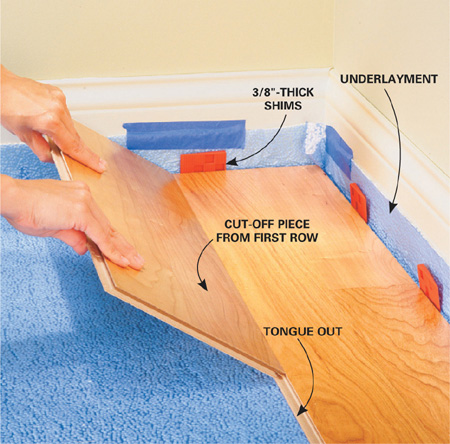
6 Start the second row with the leftover cutoff piece from the first row, making sure the end joints are offset at least 12 in. from the end joints in the first row. With the board held at about a 45-degree angle, engage the tongue in the groove. Push in while you rotate the starter piece down toward the floor. The click indicates the pieces have locked together. The joint between boards should draw tight.
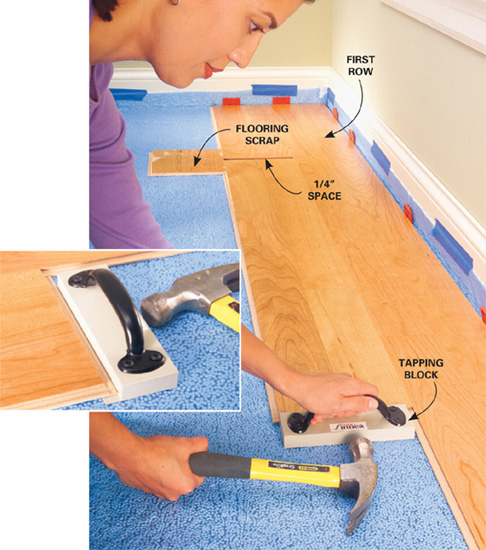
7 Leave a 1/4-in. space between the next full piece of flooring and the previous piece. Snap this piece into the first row. Snap a scrap of flooring across the ends being joined to hold them in alignment while you tap them together. Place the tapping block against the end of the floor piece and tap it with a hammer to close the gap.
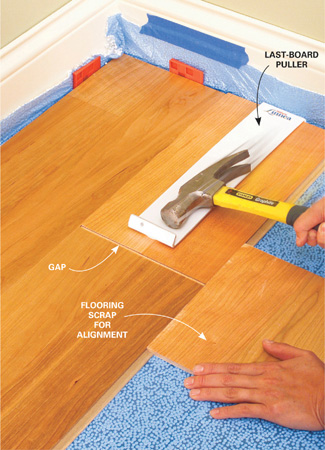
8 Close a gap at the end of the row by hooking the last-board puller tool over the end of the plank and tapping it with a hammer to pull the end joints together.
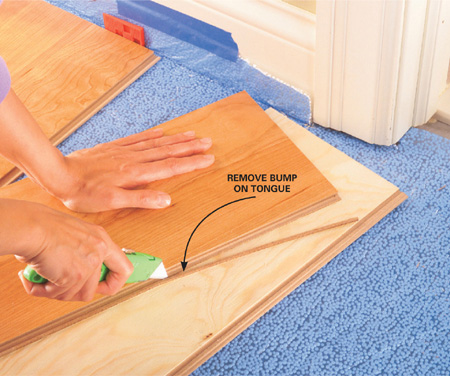
9 Plan ahead when you get near a door jamb. Usually you have to slide the next piece of flooring under the jamb rather than tilt and snap it into place. To accomplish this, you must slice off the locking section of the tongue from the preceding row with a sharp utility knife before installing it.
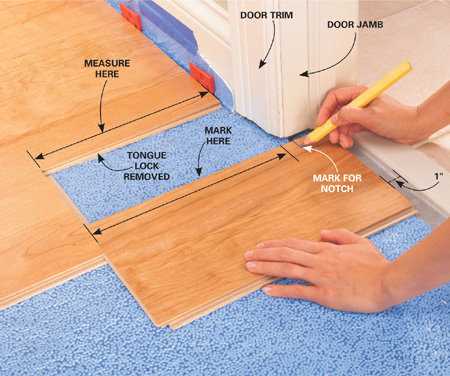
10 Cut the plank to be notched to length, allowing a 1-in. space for the future transition piece. Align the end with the end of the last plank laid and mark 3/8 in. inside the jamb to make sure the flooring extends under the door trim.
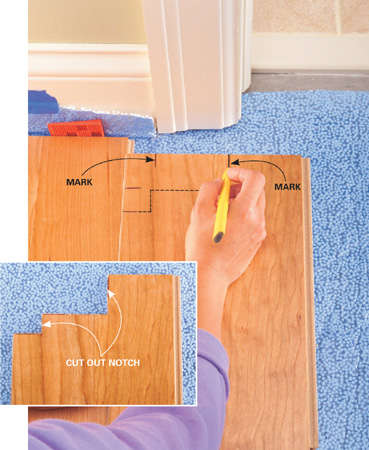
11 Align the flooring lengthwise and mark for the notches in the other direction, allowing for the floor to slide under the door jamb about 3/8 in. Connect the marks with a square and cut out the notch with a jigsaw.
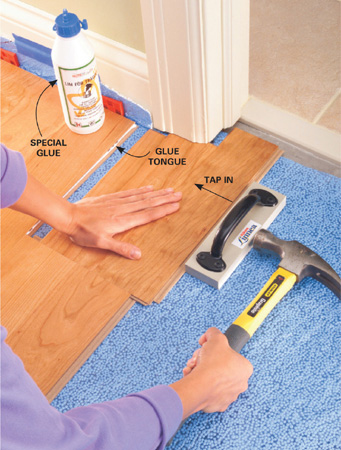
12 Apply a thin bead of the manufacturer’s recommended glue along the edge where the portion of the tongue was removed. Slide the notched piece of flooring into place and tighten the glued edge by pounding on the special tapping block.
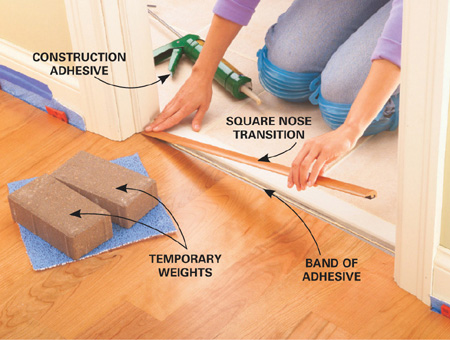
13 Cut a transition molding, in this case a square nose transition, to fit between the door stops or jambs. Spread a bead of construction adhesive only on the area of the floor that will be in contact with the transition piece. Set the transition in place and weight it down overnight.
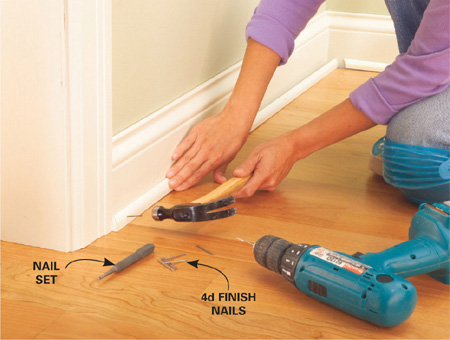
14 Complete the flooring project by trimming off the protruding underlayment with a utility knife and installing shoe molding. Predrill 1/16-in. holes through the shoe. Then nail the shoe molding to the baseboard with 4d finish nails. Set and fill the nails. Do not nail the shoe molding down into the flooring.